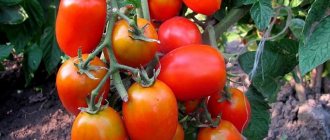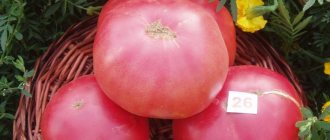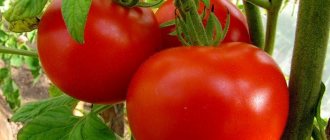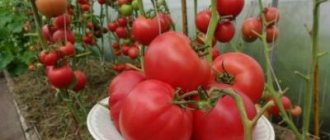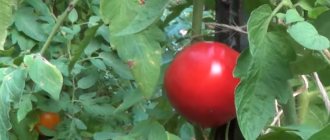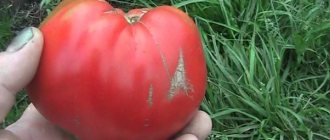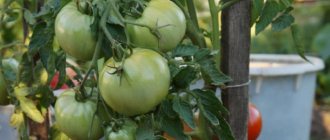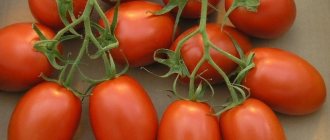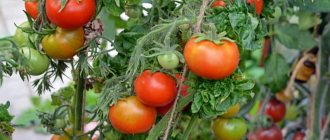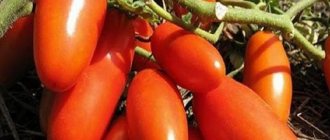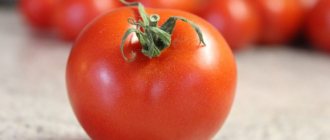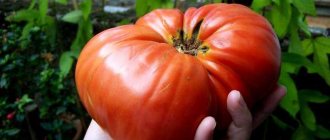Characteristics and description of the variety
The Wonder of the World is an amazing and unusual variety of tomatoes that appeared in 2002 and has already become a favorite of many gardeners, gardeners and farmers. Main varietal characteristics: indeterminate, productive and mid-season.
From planting seedlings to the appearance of fruits of varietal maturity, 100-110 days pass. The plant is large, with a strong stem and long branches. The fruits resemble lemons in both color and shape, and have a sweet taste, although there is a slight sourness.
For reference . The average weight of one fruit is about 70-100 g.
This tomato has a number of distinctive features:
- original fruit color;
- high productivity;
- resistance to a number of diseases;
- drought resistance.
The tomatoes are dense, the flesh is fleshy and also yellow.
Appearance
The fruits of the Miracle of the World tomato are quite recognizable: in few varieties they resemble ripe lemons so much. It is especially easy to guess the variety by looking at the fruiting bushes: tall, curly stems are strewn with heavy clusters of lemon-shaped tomatoes. It cannot be said that by their appearance the fruits evoke a feeling of excellent taste, and this, unfortunately, is true. But few people dare to eat lemon straight without sugar! Apparently, a person’s memory somehow works in this case, unmistakably saying that these tomatoes should either be cut into a salad, seasoned with everything necessary, or canned.
The fruits of the Miracle of the World tomato are typical lemons; the density of color depends on the degree of their maturation
How to grow seedlings
Since tomatoes of this variety are mid-season varieties, they should be planted as seedlings in the third decade of March. Before sowing, it is advisable to treat the seeds in a light pink solution of manganese. Additional treatment of seeds in potassium humate shows good results.
As soon as the seeds hatch, they must be planted to prevent the roots from overgrowing. Seeds are sown in the traditional way in a suitable container (pots, disposable plastic cups pre-filled with fertile soil).
For reference. Peat pots are the most optimal and convenient solution that will greatly simplify your work.
Humus, garden soil, and sand with the addition of potassium-phosphorus fertilizer are quite suitable for the soil. The main thing in caring for seedlings is light, regular watering as the soil ball dries out and periodic turning of the stems. Water for irrigation should be settled and warm. The air temperature is about 18 degrees at night and 22 degrees during the day.
How to grow tomatoes
Tomatoes are planted in the first ten days of June. To prevent the seedlings from withering and not lagging behind in development in the future, they should be planted in the garden immediately after being removed from the cups or from the greenhouse. The optimal distance between bushes is 1 m.
For planting, make holes with a diameter of 50 cm and a depth of at least 40 cm. A mixture of humus and the removed top layer of soil and a little complex fertilizer are added to the holes. Then water it well, and sprinkle the hole itself with dry soil on top. Take care to tie up the stem and branches with tassels, as the bush grows powerful and spreading.
In addition to high-quality tying of the stems and each cluster, regular pinching and removal of leaves is necessary after the formation of fruits below the cluster. After planting, the soil around the bushes is mulched with a 10 cm thick layer of dried mown grass or straw.
Mandatory list of measures for caring for tomatoes:
- hilling;
- loosening the soil;
- fertilizing and watering;
- bush formation and timely control of diseases and pests.
Tomatoes are planted for the first time 9-11 days after planting the seedlings. The next hilling is carried out 2-3 weeks after the first. Before starting work, be sure to water the plant to improve and speed up the emergence of new roots.
The soil in rows of tomatoes needs to be weeded, loosened and weeded approximately every 1-2 weeks.
Periodically throughout the summer, tomatoes are fed with mineral and organic fertilizers.
Important ! Fertilizer is especially necessary for weak flowering bushes.
Tomatoes are fed with nitrogen supplements or a mixture of phosphorus, copper and boron. Be extremely careful with nitrogen, as its excess can destroy the plant.
The Miracle of the World tomato is considered a drought-resistant variety, but one should not forget about timely weekly watering, especially in dry and hot summers. It is better to water tomatoes in the afternoon and at the rate of 0.7-0.9 liters of warm water per plant. Avoid excessive watering and excess moisture.
The tomato has a strong immune system, so it rarely gets sick. The plant is susceptible to tobacco mosaic viruses and brown spots. It is important to recognize diseases and take the necessary measures in a timely manner. For example, tobacco mosaic is destroyed by removing all infected tomato leaves and treating the sections with a weak solution of potassium permanganate. Brown spots are treated with the “Screen” preparation.
The main pests of tomatoes of the Miracle of the World variety are mole crickets, spider mites and greenhouse whiteflies. Treating with pepper solution will help you escape from mole crickets. In the spring, it is necessary to remove clutches of eggs, and in the fall, lay out piles of manure.
Spider mites are removed from the leaves with a soap solution. To combat greenhouse whitefly, the drug “Confidor” is used.
Bush care
How to care for plantings:
- Immediately after planting, the soil near the seedlings is mulched with a 10-centimeter layer of organic matter, using mown grass, straw, and hay;
- Water regularly, following the regime. It is advisable to water the plantings in the evening, this will allow moisture not to evaporate and penetrate into the root system;
- Carry out regular loosening of the soil and timely removal of weeds;
- Feed with fertilizers that contain phosphorus and potassium;
- When grown in greenhouses, plantings require a special microclimate. Therefore, it is necessary to regularly ventilate and shake the inflorescences to increase the yield;
- The bushes need pinching to form a stem. Otherwise, the plant will grow too much;
- During the flowering period of the second and third clusters, tomato bushes are sprayed with a solution of boric acid, this will allow numerous flowers to turn into ovaries.
REFERENCE: With this treatment you can increase the yield by 20%.
The nuances of growing in open ground and in a greenhouse
When growing tomatoes of this variety, plant care is minimal. However, it is necessary to take into account the impressive height of the plants and promptly tie them up, form a bush and sapling to prevent strong growth and weighting with fruits.
This type of tomato is best grown in greenhouses because it is afraid of wind. If this is not possible, choose an area in the open ground, protected as much as possible from wind and drafts. In the case of a greenhouse, you can plant tomato seeds at any convenient time. And when planting tomatoes in open ground, you should wait until the soil warms up to 15-18°C.
For reference. The Wonder of the World does not belong to a hybrid plant species, so the seed material can be left for next year.
Landing
Considering the climatic zones of our country, it is better to grow using seedlings. The timing of sowing seeds is chosen based on the climatic conditions of your region. In the middle zone, the procedure is carried out in early February.
Growing seedlings
Store-bought seeds are not processed. They are sown in previously prepared soil. It is bought or made independently from sand, leaf soil and turf, taken in equal parts. The distance between the seeds is at least 2 cm. After sprinkling soil on top, the contents of the container are watered with warm water and covered with a protective film.
When the first loops of seedlings appear, the covering is removed and the container is placed on the windowsill. If there is little lighting, it is recommended to buy a phytolamp and turn it on for 2-3 hours in the morning and evening. The room temperature should not fall below 22°C. To protect against root rot, seedlings are treated with Fitosporin. The working solution is prepared from 0.5 tsp of the drug dissolved in 2 liters of water.
Picking is carried out in separate containers after the appearance of two true leaves. Two and four weeks after transplantation, it is necessary to feed the plantings. To do this, 1 tablespoon of urea is dissolved in 4 liters of water. Two weeks before the expected date of transplantation into open ground or a greenhouse, the grown plants begin to accustom themselves to the new environment. To do this, they are taken outside during the warmest time of the day for 15-20 minutes.
Landing in the ground
An unusual type of tomato requires special planting. It requires slightly different conditions than for ordinary tomatoes - a 50x50 cm hole is dug under each bush, starting in the fall. 2 buckets of humus, 50 g of fertilizer with phosphorus and a little ash are added to each. 2 plants are planted in one hole, each of which should have only one trunk. If you planted one, then later the first stepson that appears is left to form a second shoot. Be sure to build a trellis, which is much more effective than stakes in supporting plantings.
Harvesting and application
Harvesting begins approximately 3 months after emergence. As a rule, this time falls in August-September. The fruits should be collected regularly so as not to create an extra, and already enormous, load on the shoots of the plant.
For reference. Regular harvesting will speed up the ripening of the remaining tomatoes.
Even if the fruit is still hard, but by external signs it looks ripe and is completely colored, you need to remove it. Before the upcoming frost, tomatoes are picked semi-ripe and left at room temperature until fully ripened.
For storage, tomatoes are placed in plastic or wooden boxes in 2-3 layers. Each layer is laid out with parchment. Tomatoes retain their marketability without refrigeration for 2-3 weeks, provided that the crop is in a dry, cool and ventilated area.
The yield of this variety breaks all records - up to 12 kg per bush! The photo clearly shows the productivity of tomato. Ripe fruits are distinguished by a high content of microelements and vitamins. This variety is good for salads and pickles. It makes excellent juice.
Farmer reviews
Tatyana, Rostov-on-Don: “The yield is really very high, I harvest more than 50 fruits from one cluster. During the flowering of tomatoes, the bushes are completely yellow with many flowers. The taste is excellent, moderately sugary.”
Anna, Pskov: “I am absolutely delighted with the new variety, this tomato is simply a miracle! Advantages: productivity, meatiness, sugar taste, not damaged by diseases. Disadvantages: requires multiple garters during the ripening process.”
Timofey, Smolensk: “I love tomatoes that are medium-sized, meaty and easy to preserve. This look fully meets all my requirements and expectations. It is very convenient to preserve tomatoes in jars and pickle them. Very beautiful fruits. The productivity will please every gardener!”
